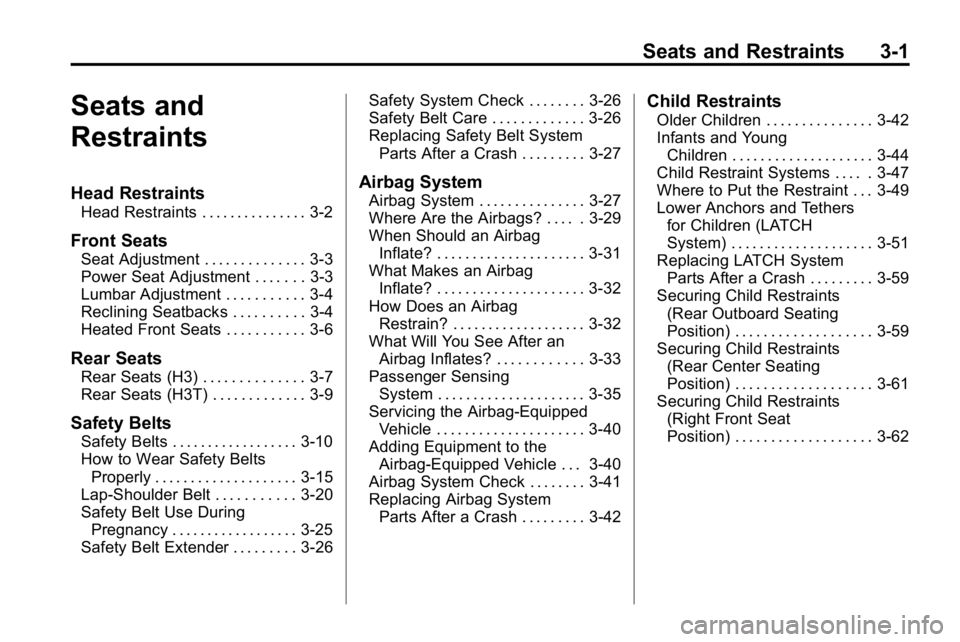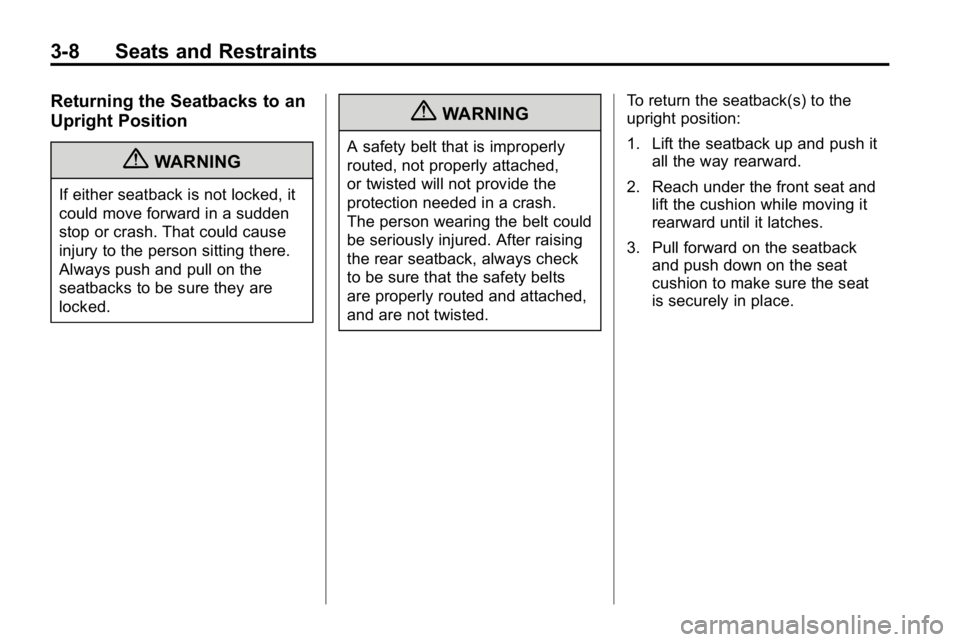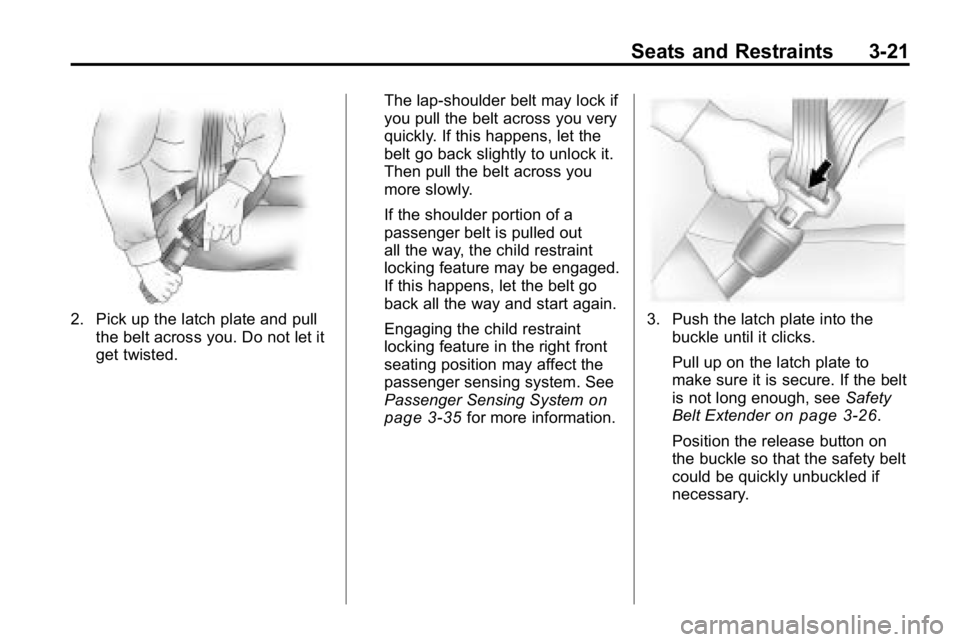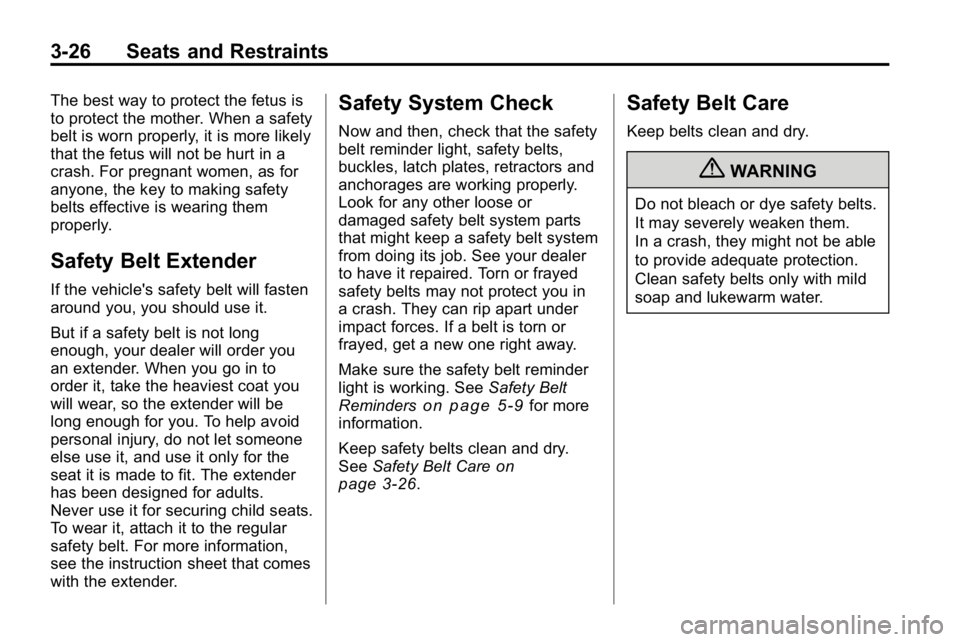2010 HUMMER H3 ECU
[x] Cancel search: ECUPage 37 of 410

Keys, Doors and Windows 2-11
If the engine stalls and the security
light flashes, wait about 10 minutes
until the light stops flashing before
trying to restart the engine. Release
the key from START as soon as the
engine starts.
If the engine does not start after
three tries, the vehicle needs
service.
If the engine is running and the
security light comes on, the engine
restarts if you turn the engine off.
However, the Passlock system is
not working properly and must be
serviced by your dealer. The vehicle
is not protected by Passlock at this
time. See your dealer for service.In an emergency, call the Roadside
Assistance Center. See
Roadside
Service on page 13‑5.
Do not leave the key or device that
disarms or deactivates the theft
deterrent system in the vehicle.
Immobilizer Operation
(Canada)
This vehicle has a passive
theft-deterrent system.
The system is automatically armed
when the key is removed from the
ignition.
The system is automatically
disarmed when the key is turned
to ON/RUN. You do not have to manually arm or
disarm the system.
The security light comes on if
there is a problem with arming or
disarming the theft-deterrent
system.
The key uses a transponder that
matches an immobilizer control unit
in the vehicle. Only the correct key
starts the vehicle. If the key is ever
damaged, the vehicle may not start.
When trying to start the vehicle,
if the engine does not start and the
security light comes on, there may
be a problem with the theft-deterrent
system. Turn the ignition off and try
again.
Page 38 of 410

2-12 Keys, Doors and Windows
If the engine still does not start, and
the key appears to be undamaged,
try another ignition key. Check the
fuse. SeeFuses and Circuit
Breakers
on page 10‑39. If the
engine still does not start with the
other key, the vehicle needs service.
If the vehicle does start, the first key
may be faulty. See your dealer who
can service the theft-deterrent
system and have a new key made.
It is possible for the theft-deterrent
system decoder to learn the
transponder value of a new or
replacement key. Up to 10 keys
can be programmed for the vehicle.
The following procedure is for
programming additional keys only.
If the keys are lost or damaged,
only a dealer can service the
theft-deterrent system to have new
ones made. Two current driver's
keys are required to program
additional keys. To program a new key:
1. Verify that the new key has
PK3+ stamped on it.
2. Insert the current driver's key in the ignition and start the engine.
If the engine does not start see
your dealer for service.
3. After the engine has started, turn the key to LOCK/OFF, and
remove the key.
4. Insert the second current driver's key in the ignition and start the
engine within ten seconds of
removing the previous key. If the
engine does not start see your
dealer for service. 5. After the engine has started,
turn the key to LOCK/OFF, and
remove the key. Insert the key to
be programmed and turn it to
ON/RUN within ten seconds of
removing the previous key.
The security light turns off once
the key has been programmed.
6. Repeat the Steps 1 through 5 if additional keys are to be
programmed.
If the security light comes on
and stays on while driving, the
engine will restart if you turn it off.
However, the theft-deterrent
system is not working properly and
must be serviced by your dealer.
The vehicle is not protected by the
theft-deterrent system at this time.
In an emergency, contact Roadside
Assistance. See Roadside Service
on page 13‑5.
Do not leave the key or device that
disarms or deactivates the theft
deterrent system in the vehicle.
Page 45 of 410

Seats and Restraints 3-1
Seats and
Restraints
Head Restraints
Head Restraints . . . . . . . . . . . . . . . 3-2
Front Seats
Seat Adjustment . . . . . . . . . . . . . . 3-3
Power Seat Adjustment . . . . . . . 3-3
Lumbar Adjustment . . . . . . . . . . . 3-4
Reclining Seatbacks . . . . . . . . . . 3-4
Heated Front Seats . . . . . . . . . . . 3-6
Rear Seats
Rear Seats (H3) . . . . . . . . . . . . . . 3-7
Rear Seats (H3T) . . . . . . . . . . . . . 3-9
Safety Belts
Safety Belts . . . . . . . . . . . . . . . . . . 3-10
How to Wear Safety BeltsProperly . . . . . . . . . . . . . . . . . . . . 3-15
Lap-Shoulder Belt . . . . . . . . . . . 3-20
Safety Belt Use During Pregnancy . . . . . . . . . . . . . . . . . . 3-25
Safety Belt Extender . . . . . . . . . 3-26 Safety System Check . . . . . . . . 3-26
Safety Belt Care . . . . . . . . . . . . . 3-26
Replacing Safety Belt System
Parts After a Crash . . . . . . . . . 3-27
Airbag System
Airbag System . . . . . . . . . . . . . . . 3-27
Where Are the Airbags? . . . . . 3-29
When Should an AirbagInflate? . . . . . . . . . . . . . . . . . . . . . 3-31
What Makes an Airbag Inflate? . . . . . . . . . . . . . . . . . . . . . 3-32
How Does an Airbag Restrain? . . . . . . . . . . . . . . . . . . . 3-32
What Will You See After an Airbag Inflates? . . . . . . . . . . . . 3-33
Passenger Sensing
System . . . . . . . . . . . . . . . . . . . . . 3-35
Servicing the Airbag-Equipped Vehicle . . . . . . . . . . . . . . . . . . . . . 3-40
Adding Equipment to the Airbag-Equipped Vehicle . . . 3-40
Airbag System Check . . . . . . . . 3-41
Replacing Airbag System Parts After a Crash . . . . . . . . . 3-42
Child Restraints
Older Children . . . . . . . . . . . . . . . 3-42
Infants and YoungChildren . . . . . . . . . . . . . . . . . . . . 3-44
Child Restraint Systems . . . . . 3-47
Where to Put the Restraint . . . 3-49
Lower Anchors and Tethers for Children (LATCH
System) . . . . . . . . . . . . . . . . . . . . 3-51
Replacing LATCH System Parts After a Crash . . . . . . . . . 3-59
Securing Child Restraints (Rear Outboard Seating
Position) . . . . . . . . . . . . . . . . . . . 3-59
Securing Child Restraints (Rear Center Seating
Position) . . . . . . . . . . . . . . . . . . . 3-61
Securing Child Restraints (Right Front Seat
Position) . . . . . . . . . . . . . . . . . . . 3-62
Page 52 of 410

3-8 Seats and Restraints
Returning the Seatbacks to an
Upright Position
{WARNING
If either seatback is not locked, it
could move forward in a sudden
stop or crash. That could cause
injury to the person sitting there.
Always push and pull on the
seatbacks to be sure they are
locked.
{WARNING
A safety belt that is improperly
routed, not properly attached,
or twisted will not provide the
protection needed in a crash.
The person wearing the belt could
be seriously injured. After raising
the rear seatback, always check
to be sure that the safety belts
are properly routed and attached,
and are not twisted.To return the seatback(s) to the
upright position:
1. Lift the seatback up and push it
all the way rearward.
2. Reach under the front seat and lift the cushion while moving it
rearward until it latches.
3. Pull forward on the seatback and push down on the seat
cushion to make sure the seat
is securely in place.
Page 54 of 410

3-10 Seats and Restraints
To return the seatback(s) to the
upright position:
1. Lift the seatback partially andreinsert the headrest.
2. Lift the seatback completely and push it into place.
{WARNING
If either seatback is not locked, it
could move forward in a sudden
stop or crash. That could cause
injury to the person sitting there.
Always push and pull on the
seatbacks to be sure they are
locked.
3. Make sure the seatback is locked by pushing and pulling
on it.
{WARNING
A safety belt that is improperly
routed, not properly attached,
or twisted will not provide the
protection needed in a crash.
The person wearing the belt could
be seriously injured. After raising
the rear seatback, always check
to be sure that the safety belts
are properly routed and attached,
and are not twisted.
4. Reconnect the center safety belt latch plate to the mini buckle.
Make sure the safety belt is not
twisted.
5. Push and pull on the latch plate to be sure it is secure.
When the seatback is not in use, it
should be kept in the upright, locked
position.
Safety Belts
This section of the manual
describes how to use safety belts
properly. It also describes some
things not to do with safety belts.
{WARNING
Do not let anyone ride where
a safety belt cannot be worn
properly. In a crash, if you or your
passenger(s) are not wearing
safety belts, the injuries can be
much worse. You can hit things
inside the vehicle harder or
be ejected from the vehicle.
You and your passenger(s) can
be seriously injured or killed.
In the same crash, you might
not be, if you are buckled up.
Always fasten your safety belt,
and check that your passenger(s)
are restrained properly too.
Page 65 of 410

Seats and Restraints 3-21
2. Pick up the latch plate and pullthe belt across you. Do not let it
get twisted. The lap-shoulder belt may lock if
you pull the belt across you very
quickly. If this happens, let the
belt go back slightly to unlock it.
Then pull the belt across you
more slowly.
If the shoulder portion of a
passenger belt is pulled out
all the way, the child restraint
locking feature may be engaged.
If this happens, let the belt go
back all the way and start again.
Engaging the child restraint
locking feature in the right front
seating position may affect the
passenger sensing system. See
Passenger Sensing System
on
page 3‑35for more information.
3. Push the latch plate into the buckle until it clicks.
Pull up on the latch plate to
make sure it is secure. If the belt
is not long enough, see Safety
Belt Extender
on page 3‑26.
Position the release button on
the buckle so that the safety belt
could be quickly unbuckled if
necessary.
Page 70 of 410

3-26 Seats and Restraints
The best way to protect the fetus is
to protect the mother. When a safety
belt is worn properly, it is more likely
that the fetus will not be hurt in a
crash. For pregnant women, as for
anyone, the key to making safety
belts effective is wearing them
properly.
Safety Belt Extender
If the vehicle's safety belt will fasten
around you, you should use it.
But if a safety belt is not long
enough, your dealer will order you
an extender. When you go in to
order it, take the heaviest coat you
will wear, so the extender will be
long enough for you. To help avoid
personal injury, do not let someone
else use it, and use it only for the
seat it is made to fit. The extender
has been designed for adults.
Never use it for securing child seats.
To wear it, attach it to the regular
safety belt. For more information,
see the instruction sheet that comes
with the extender.
Safety System Check
Now and then, check that the safety
belt reminder light, safety belts,
buckles, latch plates, retractors and
anchorages are working properly.
Look for any other loose or
damaged safety belt system parts
that might keep a safety belt system
from doing its job. See your dealer
to have it repaired. Torn or frayed
safety belts may not protect you in
a crash. They can rip apart under
impact forces. If a belt is torn or
frayed, get a new one right away.
Make sure the safety belt reminder
light is working. SeeSafety Belt
Reminders
on page 5‑9for more
information.
Keep safety belts clean and dry.
See Safety Belt Care
on
page 3‑26.
Safety Belt Care
Keep belts clean and dry.
{WARNING
Do not bleach or dye safety belts.
It may severely weaken them.
In a crash, they might not be able
to provide adequate protection.
Clean safety belts only with mild
soap and lukewarm water.
Page 73 of 410

Seats and Restraints 3-29
{WARNING
Children who are up against,
or very close to, any airbag
when it inflates can be seriously
injured or killed. Airbags plus
lap-shoulder belts offer protection
for adults and older children, but
not for young children and infants.
Neither the vehicle's safety belt
system nor its airbag system
is designed for them. Young
children and infants need the
protection that a child restraint
system can provide. Always
secure children properly in your
vehicle. To read how, seeOlder
Children
on page 3‑42or Infants
and Young Children
on
page 3‑44
.
There is an airbag readiness light
on the instrument panel cluster,
which shows the airbag symbol.
The system checks the airbag
electrical system for malfunctions.
The light tells you if there is an
electrical problem. See Airbag
Readiness Light
on page 5‑10for
more information.
Where Are the Airbags?
The driver frontal airbag is in the
middle of the steering wheel.